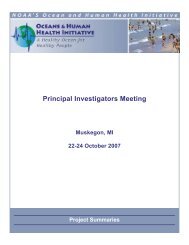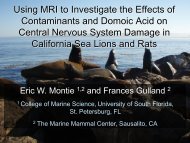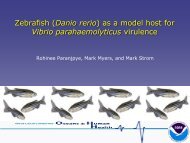A Human Health Perspective On Climate Change - The Oceans and ...
A Human Health Perspective On Climate Change - The Oceans and ...
A Human Health Perspective On Climate Change - The Oceans and ...
Create successful ePaper yourself
Turn your PDF publications into a flip-book with our unique Google optimized e-Paper software.
A <strong>Human</strong> <strong>Health</strong> <strong>Perspective</strong> ON CLIMATE CHANGEIntroductionalso directly increases the risk of injury, illness, <strong>and</strong> death, as well asindirectly by contributing to illnesses such as those associated withmental health <strong>and</strong> stress. 15Global climate change is visibly <strong>and</strong> profoundly affecting oceans,which in turn, affects human health. <strong>The</strong> warming of ocean waterscontributes to increases in incidence <strong>and</strong> severity of toxic algalblooms, alterations in aquatic <strong>and</strong> estuarine food webs <strong>and</strong> seafoodquality <strong>and</strong> availability, <strong>and</strong> effects on sentinel aquatic species 16 .High concentrations of carbon dioxide in the atmosphere increasethe amount that is dissolved into the ocean, leading to acidification<strong>and</strong> disruption of ecosystems. As large portions of the world’spopulations, including those in the United States, live in coastalareas, <strong>and</strong> many depend on marine protein for daily subsistence, theconsequences of perturbing delicate ocean <strong>and</strong> coastal systems willbe far-reaching.<strong>Climate</strong> changes including increased heat in certain arid <strong>and</strong>semi-arid parts of the United States can dramatically alter existingecosystems, presenting new challenges to agricultural production<strong>and</strong> coastal ecosystems, with consequences for food quality <strong>and</strong>availability. <strong>Change</strong>s in plant habitat can result in reduced availabilityof grazing l<strong>and</strong>s for livestock. 17 <strong>Climate</strong> changes also are directlyassociated with many pest habitats <strong>and</strong> disease vectors, <strong>and</strong> changesin temperature can extend or reorient habitats such that organismsare introduced to new geographic areas or life cycles are altered,requiring increases in pesticide use or use in new areas to achievethe same yields. Global warming is also causing shifts in the rangesof disease vectors that require specific environments to thrive (forexample, Lyme disease), 18 <strong>and</strong> increasing the threat <strong>and</strong> incidence inhumans of waterborne, vectorborne <strong>and</strong> zoonotic (those transferredfrom animals to humans) diseases.No current mitigation strategy or technology can prevent thechange in climate that has already occurred. At present, our abilityto mitigate the magnitude of the climate changes that will occurover the next 100 years is limited by the current makeup of theatmosphere, as well as what we can prevent from entering <strong>and</strong> whatwe are able to remove from the atmosphere in the future. <strong>The</strong> majortargets of climate change mitigation strategies include alternativefuels <strong>and</strong> energy conservation, changes in l<strong>and</strong> use patterns, sustainabledevelopment of the built environment, <strong>and</strong> carbon capture<strong>and</strong> storage. 19 Switching from fossil fuels <strong>and</strong> other greenhouse15 Noyes, PD, et al., Environment International, 2009. 35(6): p. 971-986.16 United States. Congress. Senate. Committee on Commerce Science <strong>and</strong> Transportation. 2003, Washington: U.S.G.P.O. ii. 8 p.17 Ericksen, PJ, et al., Environmental Science <strong>and</strong> Policy, 2009. 12(4): p. 373-377.18 Estrada-Peña, A, Environ <strong>Health</strong> Perspect, 2002. 110(7): p. 635-40.19 Haines, A, et al., Lancet, 2006. 367(9528): p. 2101-2109.gas-emitting energy sources to cleaner alternatives <strong>and</strong> using carboncapture <strong>and</strong> storage technologies will slow the rate at which werelease greenhouse gases into the environment. Energy conservation<strong>and</strong> modifications in energy use will also reduce releases. L<strong>and</strong> usechanges such as restricting the destruction of forests <strong>and</strong> replantingmore trees will serve to increase natural carbon storage.Actions to preserve other ecosystem services, such as flood controlby protecting wetl<strong>and</strong>s or vector control by conserving biodiversity,can also reduce the severity of climate change-related problems. 20Finally, changes in building codes, transportation infrastructure,housing density, coastal development, <strong>and</strong> other urban planningstrategies can reduce energy usage <strong>and</strong> thereby mitigate someportion of climate change. Through these changes in humanactivities <strong>and</strong> practices, we should be able to limit the magnitude ofthe changes to the planet’s climate, <strong>and</strong> thus, reduce the negativeimpacts to human health. Though it is possible that some mitigationstrategies may exacerbate known human health stressors orintroduce unanticipated potential for human harm, many strategieswill provide co-benefits, simultaneously reducing the negative effectsof climate change while also reducing illness <strong>and</strong> death. For example,reducing harmful air pollutants generally decreases global warmingbut is also just more healthful to people. 21Recognizing that there are a broad set of issues related to bothpotential benefits <strong>and</strong> possible adverse effects on human healthresulting from mitigation <strong>and</strong> adaptation strategies, the IWGCCHdid not attempt to outline research needs for mitigation <strong>and</strong> adaptionin a comprehensive manner in this report, nor provide a comprehensiveoverview of mitigation <strong>and</strong> adaptation approaches. <strong>The</strong>se issues<strong>and</strong> their associated research needs will have to be evaluated in thecontext of the individual options <strong>and</strong> strategies. Instead, this reportfocuses on some of the broader mitigation <strong>and</strong> adaptation optionsthat are currently under development that have the potential toprovide great benefits to human health <strong>and</strong> proposes research needsthat could inform decisions relating to them, <strong>and</strong> examples of mitigation<strong>and</strong> adaptation needs related to certain health consequences areincluded within each chapter.Adapting to or coping with climate change will become necessaryin the United States <strong>and</strong> around the world. Most adaptationstrategies seek to change the human environment <strong>and</strong> decrease thepotential for illness <strong>and</strong> death by helping to prevent some of theworst consequences of climate change. <strong>The</strong> primary environmentalfactors targeted for adaptation are water security <strong>and</strong> food security.20 Corvalán, C, et al. 2005, [Geneva, Switzerl<strong>and</strong>]: World <strong>Health</strong> Organization. 53 p.21 Smith, KR, et al., Lancet, 2009.6 www.niehs.nih.gov/climatereport










